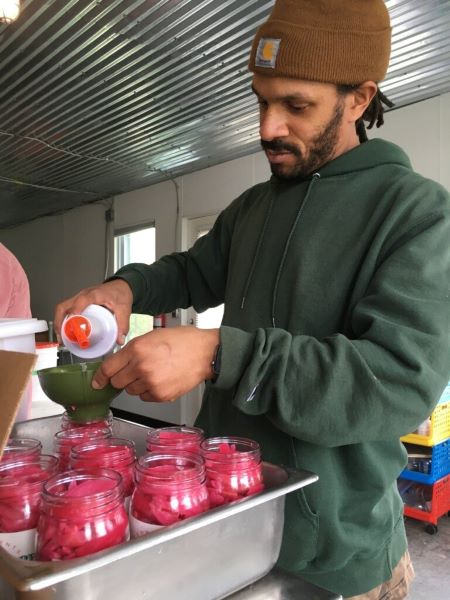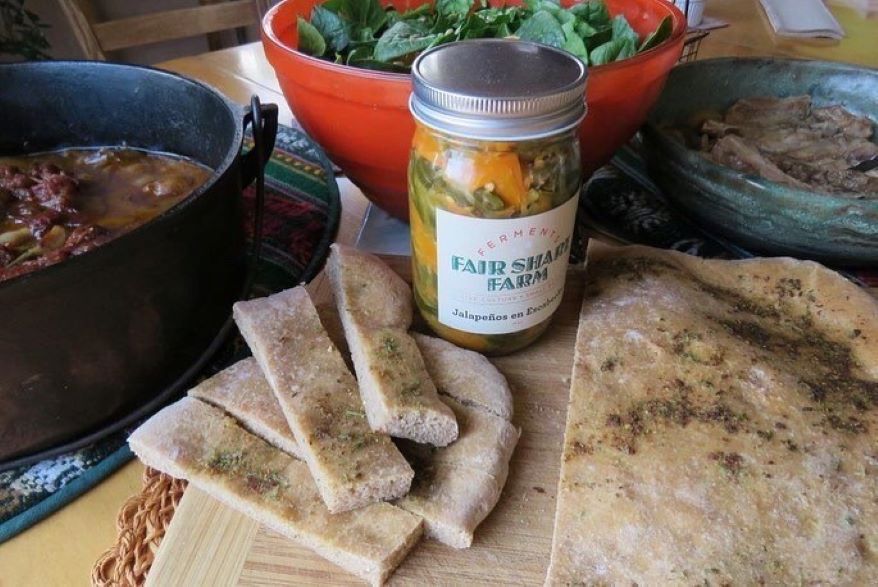Focus on Food Fermentation at Fair Share Farm ‘Feed the Soil, Feed the People’
Published May 27th, 2022 at 9:00 AM
Above image credit: For nearly two decades, Fair Share Farm in Kearney, Missouri, offered a traditional participatory CSA. More recently, the vegetables are being used in traditional recipes for fermented foods. (Contributed | Fair Share Farm)The kitchen at Fair Share Farm in Kearney, Missouri, doesn’t require a stove.
Instead of heat, farmers Tom Ruggieri and Rebecca Graff rely on fermentation to transform their organic vegetables into handcrafted jars of sauerkraut, jalapeños en escabeche, curtido, kimchi, green kimchi, beet relish, daikon pickles, garlic pickle chunks and bottles of hot sauce.
Fermentation is the chemical breakdown of a substance by bacteria, yeasts, or other microorganisms. The process naturally creates heat that results in the creation of foods such as cheese, buttermilk and yogurt, as well as beverages such as beer, wine and spirits.
Fermentation on the farm starts with big tubs of chopped vegetables that are salted, seasoned and mixed, then transferred to 50-pound fermenting buckets. Sauerkraut is fermented for 21 days at 70 degrees while kimchi takes 10 days and pickles take three or four days. The finished batches are stored in a cooler at 34 degrees Fahrenheit until it is time to pack the jars for sale.
“It will keep indefinitely. It’s preserved, but alive,” Ruggieri says of the line of products sold under the Fair Share Ferments label and available at Brookside Farmers Market and a dozen local retailers.
“Feed the Soil, Feed the People” has become the farm’s motto, and it turns out what is good for the earth is also good for us because fermentation produces live cultures that are considered a natural digestive aid.
For nearly two decades, Ruggieri and Graff offered subscription shares of vegetables grown on the farm for purchase through a CSA, the abbreviation for Community Supported Agriculture. Fair Share Farm’s participation model included 150 families contributing to the harvest.

“We lost the community when COVID hit, and we saw just how much members actually did,” Graff says. “There’s a lot of handling that doesn’t have anything to do with growing. Washing and packaging is half the labor of the farm.”
The break in their normal routine gave Ruggieri and Graff time to reassess their operation and make a pandemic pivot. While the ferments provided income, the land which had been in Graff’s family for four generations got a facelift.
Instead of a conventional grid, drone footage offers a view of fields that appear to undulate. The farm has been reshaped by the addition of 7,000 feet of berms and swales, a series of depressions and ridges etched into the land with a plow to help drain water while conserving the soil.
“Our soil … just isn’t quite the ground to put a bunch of rectangular vegetable beds on. We’re not a river bottom, and it took us all that time to realize that,” Ruggieri says.
They use a combination of cover cropping, mulching, compost application, chicken rotations, mineral additions and water management. They have added 100 Chinese chestnut saplings and other perennial crops, such as persimmons, pawpaws, hazelnuts and elderberries that they plan to ferment into raw vinegar.
“Giving your soil a diverse diet is really important,” Ruggieri says. “You are what you eat, so you are what your plants eat. The soil is the guts of the plant. It’s where all the digesting happens, and the nutrients are absorbed by the plant.”
Layers of Flavor
Kendall Harris refers to himself as the “junior chief fermenter” for Fair Share Farms.
Harris, who started his career in culinary arts behind the bar and then at a juice shop, currently works with chef Nick Goellner at The Antler Room, who apprenticed with René Redzepi at Noma in Copenhagen, at one time considered the best restaurant in the world.

“I get two different perspectives on fermentation between Tom and chef Nick,” says Harris, who has plans to open a fermentation lounge next year in Martini Corner.
When an agricultural tour group stops by the farm, Harris puts together a lunch designed to illustrate the many layers of flavor fermentation can offer.
On a bed of seared polenta, Harris combines sauteed carrots, mushrooms, and onions with strawberry vinegar then adds curtido, a fermented slaw traditionally served atop pupusas in El Salvador.
He tops the vegetables with a fried egg, more curtido and a sprinkle of powdered escabeche, a Spanish fermented jalapeno slaw that did not pass muster for the jar, so it was dehydrated and pulverized to use as a seasoning. The dish is finished with a drizzle of fermented garlic honey.
While the chef’s perspective is a welcome addition to the process, the focus at the farm is on perfecting traditional recipes, for which they have received plenty of compliments “from people who would know.”
Ruggieri recalls a Korean woman at the Brookside Farmers Market who remarked after tasting a sample: “That’s authentic kimchi.”
Meanwhile, the jalapeño en escabeche was a 2021 finalist in the prestigious annual Good Food Awards recognizing responsibly produced artisan foods from around the country.
“We like to say what we do isn’t art, it’s a craft. We didn’t come up with recipes for escabeche or curtido or sauerkraut,” Ruggieri says. “This is really more about farming than fermenting. Over 95 percent of everything that is in the jar is raised on the farm, and that is by far the hardest part of this job.”

Listening to the Land
Jennifer Rouyer of Brookside routinely adds kimchi to eggs and jalapeños in escabeche to her sandwiches.
She and her husband, David Rouyer, signed up for a Fair Share Farm CSA when their adult children were young.
For years, they would wake the kids up early Saturday mornings and head for the farm to snip lettuce or pluck peas off the vine. The family also got to taste test the earliest samples of Fair Share Farm Ferments.
“We felt very sad to see that (CSA) era end, but by the same token we saw Tom and Rebecca were working so hard. With the ferments we feel grateful they are still passionate about feeding people,” Jennifer says.
Ruggieri monitors each batch of fermented vegetables and records temperatures, acidity and more using a three-ring binder which contains a Hazard Analysis Critical Control Point, referred to as HACCP plan.

The plan is designed to ensure food safety. Most home cooks have been trained to worry about foods sitting out for more than two hours at room temperature. But under the right conditions “it’s totally safe. It’s something that has been going on for centuries,” he says.
Ruggieri is encouraging Harris and other chefs to use aspects of Fair Share Farm’s HACCP plan to streamline their businesses and push naturally fermented foods into the mainstream.
Step outside the fermentation kitchen and the farmers wear knee-high rubber boots to walk around moist berms surrounded by fluffy grasses softly blowing in the wind. Birds are chirping, chickens are pecking as Graff points to a berm where Napa cabbage is just starting to leaf out.
Climate change is bringing bigger rain events. Sometimes the land gets drenched with 10 inches in two weeks versus an inch or two a week that would allow the vegetables to thrive.
“It’s been a journey. We’re totally changing how we’re farming this land,” Graff says. “The fermentation process was kind of happening at the same time, and both are related. But when we were farming 30 crops for 150 families, we didn’t have time to listen to the land.”
Jill Wendholt Silva is a James Beard award-winning food editor and freelance writer. You can follow Silva at @jillsilvafood.


